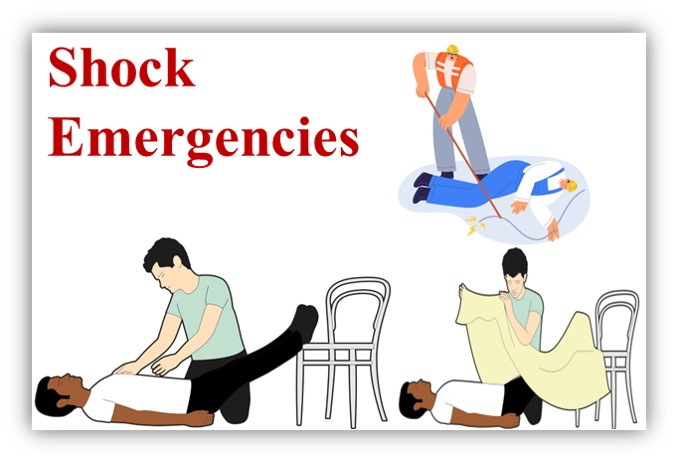Shock Emergencies
Shock is a condition resulting from a depressed state of many vital body functions due to decreased tissue perfusion. It is a condition that could threaten life.
Traumatic shock, electrical shock, insulin shock, hypovolemic shock and other special forms of shock are among the various types of shock. Even though the victim’s injuries would not otherwise be fatal, shock can threaten the life of the victim.
Causes
- Hemorrhage
- Severe vomiting and diarrhea.
- Burn.
- Infection.
- Heart attack or stroke.
- Poisoning by chemicals gases, alcohol or drugs.
- Other causes like stress, pain, temperature instability, and delay of treatment.
- And many other underlining causes.
Signs and Symptoms
- Pale or bluish skin and mucus membrane, cold extremities to touch.
- Moist and clammy skin.
- Weakness.
- Rapid and weak pulse and too faint to fell at the wrist but perceptible in the carotid artery (figure 26).
- Rapid and shallow breathing especially in case of abdominal and chest injury.
- Low blood pressure.
- Restlessness, anxiety severe thirst, vomiting or retching.
- The victim becomes apathetic and relatively unresponsive.
- The victim’s eyes are sunken with a vacant expression, and his pupils may be totally dilated.
- Unconsciousness and hypothermia, finally death.

Treatment Objectives
- To identify and treat the cause.
- To improve circulation.
- To ensure an adequate supply of oxygen
- To maintain normal body temperature.
- To transfer the patient to health facility immediately.
First Aid Measures
Body Position
- It must be based on type of injuries. The most satisfactory position for the injured person will be lying down to improve the circulation of the body.
- If injury is on the neck or spine, don’t move the victim until he is prepared for transportation.
- A victim with severe wounds of the lower part of the face and jaw or who is unconscious should be placed on his side to facilitate drainage of fluids and to avoid air way blockage.
- A person with a head injury may be kept flat or propped up but his head must not be lower than the rest of his body.
- Raise foot of the stretcher or bed from 20-30 inches for other types of injuries.
Regulating Body Temperature
Keep the victim warm enough to avoid or overcome chilling. If the victim is exposed to cold or dampness, blankets or additional clothing should be placed over and under him to prevent chilling.
Administering Fluids
- Give fluids by mouth if there is no medical help near by, discontinue fluids if the victim becomes nauseated or vomits.
- Don’t give fluid by mouth if:
- Victim is unconscious
- Victim is vomiting or about to vomit and having a convulsion.
- When a victim likely to have surgery or anesthetic or have brain or abdominal injury.
Note – When the victim is conscious give plenty of fluids prepared from half teaspoon of salt, two to three tablespoons of sugar or honey and some orange or lemon juice in a litter of water. Encourage the victim to drink as often as possible especially until he/ she urinates frequently.

